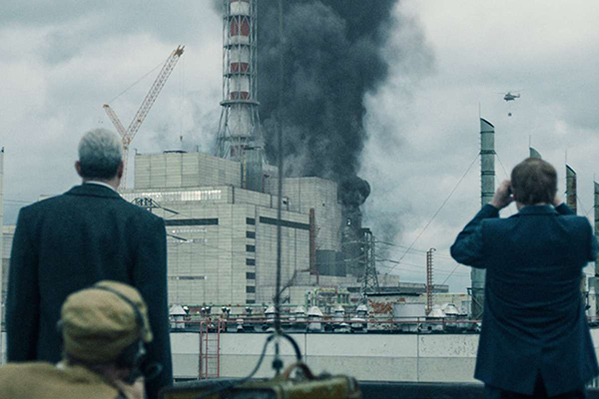In case you missed it, the final episode of the highly acclaimed five-part HBO miniseries “Chernobyl” aired last night. When the credits rolled, I let out a pent-up breath that I didn’t know that I was holding in and slumped back in my seat, finally able to relax. The show was over, but the weightiness of its message and atmosphere lingered on, sticking with me even as I laid down to sleep.
“Chernobyl” dramatizes the events leading up to and following the nuclear disaster at the Vladimir Lenin Nuclear Power Station just outside of Pripyat, Ukraine. It immediately takes a personal, character-driven focus on the events, each episode following the story of a particular person or group of people whose lives were irrevocably changed when the Unit 4 reactor at the plant exploded on April 26, 1986, releasing massive amounts of radioactive material into the atmosphere during the worst nuclear disaster in history.
While “Chernobyl” took some liberties with the sequence and details of events and the people involved, it still managed to faithfully retell the overall story of the disaster and give a heart-wrenching look at the human impact. And it never stopped delivering blow after blow to the Soviet mismanagement, corruption, and secrecy that enabled the catastrophe.
The entire series focuses on the failings at each level of the Soviet state. From incompetent and undertrained nuclear technicians, to ambitious supervisors who ignored safety protocols, bureaucratic red tape halting action to limit the damage, and Soviet state secrecy trying to cover up the truth and save face on the world stage. The creators of “Chernobyl” lay waste to the Soviet machine while hailing as heroes the brave men and women who lived, toiled, and died striving to contain the disaster.
The show’s main character, a Russian nuclear physicist named Valery Legasov (brilliantly played by Jared Harris), binds the whole enterprise together, engaging with his counterpart Ulana Khomyuk (who represented the dozens of scientists who aided Legasov during the events in reality) in a sort of nuclear detective story as they try to piece together what caused the disaster while desperately trying to contain the damage.
Over just five episodes, we see Legasov develop as a character, his early horrified naiveté replaced by a world-weary stoicism as he faces down both the invisible killing power of Chernobyl’s radiation and the pressure of the immense Soviet bureaucratic machine seeking to cover up the truth. Even in the face of these obstacles and the human cost of what must be done to contain the damage, he still holds onto his earnest desire to help others and prevent another disaster from happening. Cigarette in hand, aided and supported by Khomyuk and his adversary-turned-friend Boris Shcherbina, he labors on tirelessly to the end, delivering one of the finest layman-level technical explanations of the Chernobyl disaster I’ve ever seen alongside a scathing condemnation of the Soviet state a la “The Gulag Archipelago” in his testimony during the post-disaster Soviet show trial. This segment alone makes watching the series worth it.
The production quality of the series was top-notch. Era-faithful wardrobe and set design as well as a life-size mockup of the destroyed reactor building were painstakingly made to immerse the viewer in the world. This alongside the droning, pulsating music and excellent sound design wove together a thick, foreboding atmosphere that settles on the viewer like a cloud of radioactive smog.
There’s something in the series for everybody: from the anti-communist, to the history buff, to the nuclear physicist, to the drama junkie. If you haven’t yet seen “Chernobyl”, do yourself a favor and give it a look. This is some of the best that television has to offer.
Featured image courtesy IMDb and HBO. Still from promo trailer.
